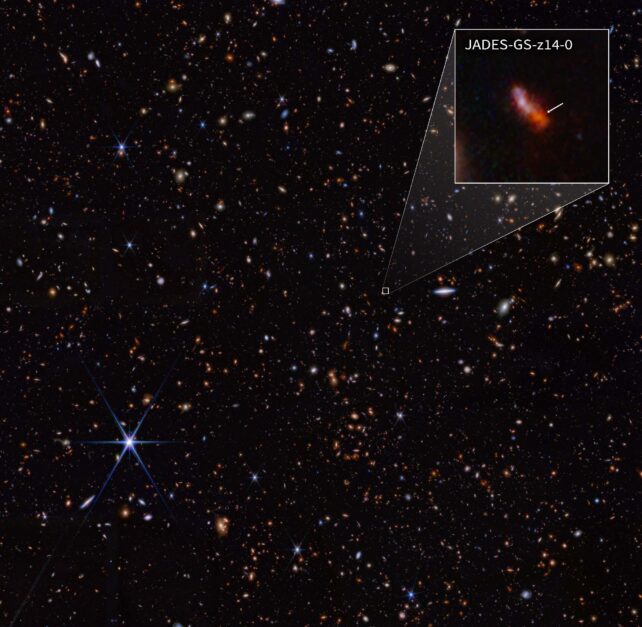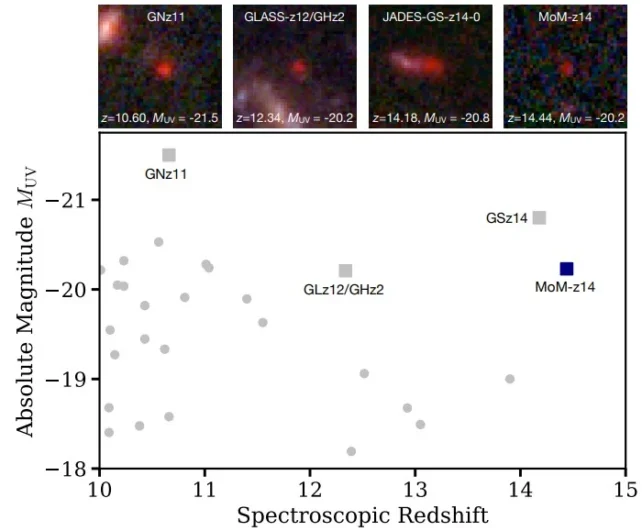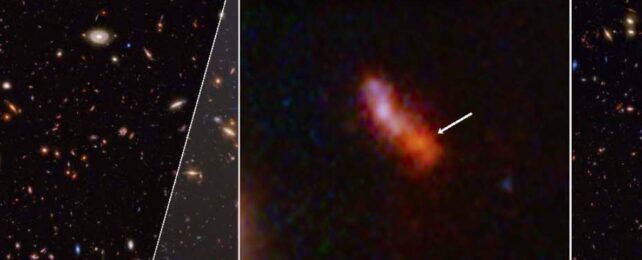The JWST has done it again. The powerful space telescope has already revealed the presence of bright galaxies only several hundred million years after the Big Bang.
Now, it's sensed light from a galaxy only 280 million years after the Big Bang, the most distant galaxy ever detected.
Prior to the JWST, we had no infrared telescopes with large enough mirrors to detect light from the early galaxies.
The Hubble can see near-infrared light, but only has a 2.4-meter mirror. It found only one galaxy from the Universe's 500 million years. The Spitzer Space Telescope was a dedicated infrared telescope, but it only had an 85 cm mirror.
Not only does the JWST have a much larger mirror, but detector technology has advanced so much that the veil obscuring the early Universe is being lifted one ancient galaxy at a time.
One of the JWST's primary science themes is the Assembly of Galaxies. We need to see the Universe's earliest galaxies to understand how they form and evolve. Within weeks of beginning observations, the telescope found an abundance of bright galaxies at redshifts greater than z=10.
"This unexpected population has electrified the community and raised fundamental questions about galaxy formation in the first ≈ 500 Myrs," the authors of a new paper write.
The JWST has consistently pushed back our observation horizon, and this newest detection shows it may not have reached its limit yet.

The newly discovered galaxy is named MoM-z14, and it comes from the Mirage or Miracle survey. This spectroscopic survey is designed to confirm high-redshift candidate galaxies, and z14 refers to the galaxy's redshift. This finding is surprising because astronomers expected to find very few galaxies at such a high redshift.
The discovery is presented in a new paper titled "A COSMIC MIRACLE: A REMARKABLY LUMINOUS GALAXY AT zspec = 14.44 CONFIRMED WITH JWST." The lead author is Rohan Naidu from the MIT Kavli Institute for Astrophysics and Space Research. The paper's been submitted to the Open Journal of Astrophysics and is available at arXiv.org.
"JWST has revealed a stunning population of bright galaxies at surprisingly early epochs, z > 10, where few such sources were expected," the authors write. At a redshift of z = 14.4, this galaxy "expands the observational frontier to a mere 280 million years after the Big Bang."
They point out that the JWST has found far more bright galaxies between z = 14 and 15 than the consensus showed before its launch.
This study isn't just another curiosity. The spectroscopic examination revealed interesting results related to the JWST's Assembly of Galaxies theme.

Observations show that most of the galaxy's light comes from stars, not an active galactic nucleus (AGN). AGN are the bright cores of galaxies powered by supermassive black holes accreting matter. So MoM-z14 likely hosts some luminous supermassive stars, something that theory predicted about the early Universe.
The galaxy's nitrogen-to-carbon ratio is higher than that observed in the Sun. Its chemical composition resembles ancient globular clusters attached to the Milky Way. This means that the stars in the galaxy and those in globular clusters formed in similar environments with similar nucleosynthesis and metallicity pollution from previous stars.
"Since this abundance pattern is also common among the most ancient stars born in the Milky Way, we may be directly witnessing the formation of such stars in dense clusters, connecting galaxy evolution across the entire sweep of cosmic time," the authors write.
There seem to be two morphologies for these ancient bright galaxies: point source and extended. The relation between their morphologies and their chemistry is another potential link in galaxy evolution.
"Furthermore, as noticed by Harikane et al. (2024b), these morphological differences are reflected in chemical abundance patterns, signalling a deeper connection between morphology and evolutionary pathways," the authors write.
As the JWST has found more ancient bright galaxies, a class of objects that are strong nitrogen emitters has become apparent, including luminous Little Red Dots. MoM-z14 could be among the most nitrogen-enhanced objects the JWST has ever found.
"It adds further evidence for a size-chemistry bimodality at z > 10, wherein extended sources tend to be nitrogen weak while compact sources are strong N emitters," the authors explain.
The space science community waited a long time for the JWST and its ability to observe the early Universe. While some of its findings have been surprising, this study shows how astronomers are finding connections between the surprises revealed in the early Universe and the modern Universe.

"We interpret MoM-z14 and N-emitters through Galactic archaeology, connecting their abundance patterns to the most ancient stars born in the Milky Way at z ≳ 4 as well as to globular clusters," the authors write in their conclusion.
"The N-enhancement, brightness, hard ionizing spectra, stellar density, morphology, redshift dependence, and black hole fraction of these sources may be linked to globular cluster-like environments wherein runaway collisions may produce extraordinary objects such as supermassive stars."
If it survives repeated cancellation threats, the Roman Space Telescope should reveal hundreds more of these types of galaxies. A larger dataset is always desirable and would help solidify some of these findings, or maybe introduce new mysteries. Either way, it'll be progress. But for now, the James Webb Space Telescope deserves the spotlight for this discovery.
"JWST itself appears poised to drive a series of great expansions of the cosmic frontier, previously unimaginable redshifts, approaching the era of the very first stars, no longer seem far away," the researchers conclude.
This article was originally published by Universe Today. Read the original article.
